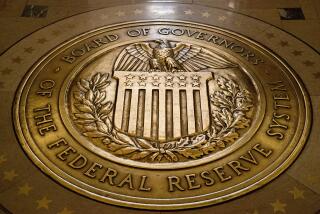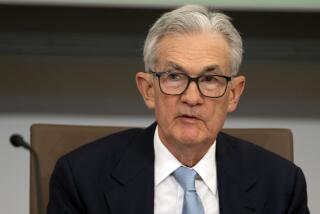Fed seeks economic boost by shifting its bond mix
After three years of trying to pump up the flailing economy with little effect, the Federal Reserve pulled out a weapon that hasn’t been used in half a century in an attempt to prod wary businesses, lenders and consumers to get off their hands and open their wallets.
The new Fed stimulus plan, announced Wednesday in a statement that also had a sobering assessment of the economy, came amid opposition from Republican leaders and deepening economic concerns globally.
Under the $400-billion initiative, which Wall Street dubbed Operation Twist, the Fed will sell some short-term Treasury bonds in its portfolio and buy long-term ones in an effort to pull down long-term interest rates, including on mortgages, and spur more borrowing and spending.
With U.S. unemployment stuck above 9% and no new major fiscal stimulus likely to come from a gridlocked Congress, the Fed is seen as the economic policymaker of last resort.
“They want to appear to be doing something,” said Dean Croushore, an economics professor at the University of Richmond. “They don’t think it’s going to hurt, it could help a little bit, so why not?”
Many analysts doubt the Fed’s plan will do a whole lot to speed up job growth or the stalled economy. Interest rates, after all, are already at record lows. It’s job security, stagnant incomes and depressed home values that are dampening borrowing and spending, economists said.
The immediate effect of the action was to drive long-term Treasury bond rates lower — a good thing for mortgage shoppers — and fling stock markets into a dive. The Dow Jones industrial average lost nearly 284 points, or 2.5%, its biggest point and percentage drop since Sept. 9.
Fed Chairman Ben S. Bernanke engineered the latest policy measures with considerable objection within the institution’s own ranks; three of the 10 voting members dissented.
Whereas some past Fed stimulus moves flooded the financial system with hundreds of billions of dollars, setting off fears of spiraling inflation down the road, the new plan won’t involve printing more money. Rather, it will simply change the mix of the central bank’s huge bond portfolio.
The Fed also said it would reinvest in more mortgage-backed securities, a move intended to help the depressed housing market.
The average 30-year home loan rate in mortgage giant Freddie Mac’s weekly survey was a record-low 4.09% last week, down from 4.60% in early July. Many analysts said Wednesday that they expected the average rate to fall below 4% soon.
While prospective home buyers are concerned about their jobs, home values and banks’ tightfisted lending policies, many businesses are reluctant to hire and expand in the face of weak demand, financial turmoil in Europe and fractious politics at home.
“Really, it’s not a problem interest rates are too high,” said Croushore, who added that he would have preferred the Fed stand pat. He noted that research from Bernanke and others showed the original Operation Twist produced very modest results in the early 1960s.
Bernanke himself has suggested that the economy would benefit from a shot of fiscal stimulus, insisting that the Fed’s manipulation of interest rates and other monetary policies provide no panacea for the prolonged joblessness and other problems threatening the future of the nation’s economy.
The Fed’s dual mandate is to maximize employment and foster stable prices. Inflation, while creeping higher earlier in the year, appears to have eased as energy and commodity prices have come down. The Fed said Wednesday that longer-term inflation expectations have remained stable.
Bernanke’s Fed has taken unprecedented steps in the last few years to lower interest rates and stimulate the economy.
The Fed’s conventional policy tool — its benchmark short-term rate that influences many types of loans — has been near zero since December 2008. On Wednesday, policymakers reaffirmed their pledge to keep the so-called federal funds rate near zero until at least mid-2013.
In launching Operation Twist, the Fed opted against a more aggressive and politically riskier step of undertaking another round of outright bond purchases.
Over the last three years of the recession and weak recovery, the central bank has bought billions of government bonds and other securities to spur lending and growth, expanding its holdings to nearly $2.7 trillion. The moves have led critics to say the result will be a weak dollar and higher inflation.
GOP presidential candidates have taken turns lobbing criticisms at the central bank. On Monday, on the eve of the Fed’s two-day policy meeting, top Republican lawmakers took the unusual step of sending Bernanke a letter urging him to avoid further stimulus moves.
The Fed statement included a bleak but slightly improved assessment of the economy. Instead of the economy growing “considerably slower” than expected, the statement Wednesday said growth “remains slow,” with the committee continuing to expect “some pickup in the pace of recovery over coming quarters.”
At the same time, the latest statement warned of “significant downside risks to the economic outlook, including strains in global financial markets,” referring to the European debt crisis.
With Operation Twist, the Fed said that by mid-2012 it would sell $400 billion in shorter-term Treasury securities and use the proceeds to buy an equal amount of Treasuries with maturities of six years or longer.
The 10-year Treasury note yield, a benchmark for mortgage rates, fell Wednesday to 1.86% from 1.94% on Tuesday. It was the lowest rate in at least 60 years.
But by encouraging investors to buy bonds, which rise in value as market interest rates fall, the Fed in effect undercut demand for stocks, analysts said. Shares plummeted after the announcement, with broader indexes following the Dow. If stocks continue to fall, it could offset much of the benefit of lower interest rates.







